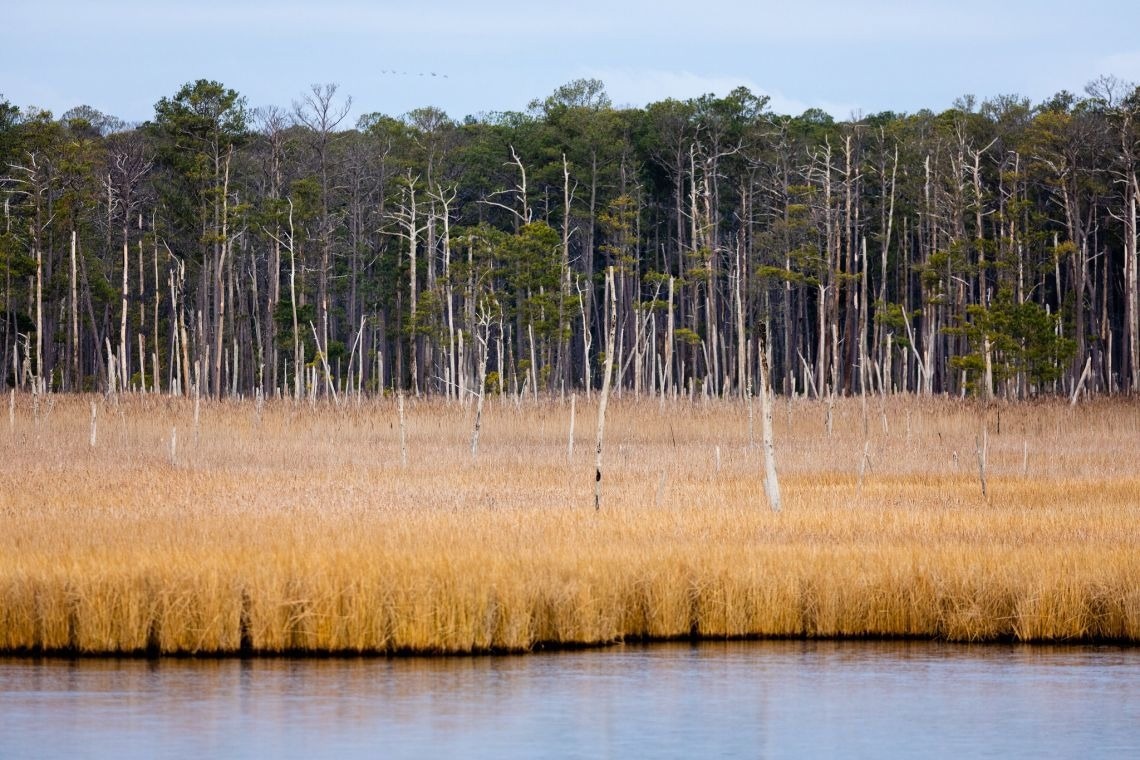A new modeling study headed by scientists at Duke University has found that increasing sea levels shift marshes inland in six mid-Atlantic states, and the coastal zone will not continue to serve as a carbon sink but instead will release more carbon into the atmosphere.
 The study area of mid-Atlantic coastlines includes the Blackwater National Wildlife Refuge in Dorchester County, Maryland. Image Credit: Chesapeake Bay Program.
The study area of mid-Atlantic coastlines includes the Blackwater National Wildlife Refuge in Dorchester County, Maryland. Image Credit: Chesapeake Bay Program.
Earlier estimates concentrated on the ability of an expanded area of coastal marshes to capture a high amount of carbon, thereby eliminating it from the air where it serves as a greenhouse gas in the form of carbon dioxide.
However, as coastal marshes tend to invade freshwater wetlands and low-lying forests, the loss of trees and decomposition will liberate more carbon into the atmosphere compared to what can be captured by the marshes. This will also contribute to global climate change.
The study was performed in discussion with natural resource agencies in North Carolina, New York, New Jersey, Delaware, Maryland, and Virginia. Maps of forecasted changes in coastal habitats and carbon as a result of the sea level increase were made to support coastal planning.
This research and our conversations with the states raise lots of questions about options for managing coastal landscapes given these changes, and emphasizes the importance of reducing greenhouse gases and sea level rise overall, because that's the main driver of all this.
Katie Warnell, Study Lead Author and Policy Associate, Nicholas Institute for Environmental Policy Solutions, Duke University
Warnell added, “There are many other reasons to keep marshes around, including coastal protection and nursery habitats for fisheries. We need to weigh all of these different factors in making decisions about managing our coastal habitats.”
The renowned, open-access study was reported in the PLOS Climate journal on June 23rd, 2022.
The modeling runs focused on land changes in coastal areas throughout the year 2104 in cases that forecast intermediate sea level increases. In 16 out of the 19 runs of the model, inland marsh migration transformed the land from a net carbon sink to a net carbon source.
There might be some things that can be done to protect key areas from converting. In North Carolina, berms and pumps have been used to protect agricultural land and towns from sea level rise. While these are expensive, they might be worth it in certain areas.
Katie Warnell, Study Lead Author and Policy Associate, Nicholas Institute for Environmental Policy Solutions, Duke University
According to Warnell, one more possible option is the preemptive forest harvest in susceptible areas to stop carbon from penetrating the air upon decomposition. As sea levels begin to rise and cause saltwater to replace freshwater, trees in some low-lying regions are dying and developing ominous-looking “ghost forests.” The tree deaths decrease carbon storage and liberate carbon via decomposition.
In this new study, Warnell and others have made initial estimates of the carbon costs associated with the drowning and salinization of coastal wetland ecosystems.
Emily Bernhardt, Professor, Nicholas School of the Environment, Duke University
Bernhardt added, “These early estimates suggest that habitat transitions caused by sea-level rise across the Mid Atlantic coastal plain will shift coastal ecosystems from carbon sinks to carbon sources without thoughtful intervention.”
Bernhardt has broadly studied ghost forests in the eastern United States.
The new study performed by Warnell was done along with Lydia Olander of Duke’s Nicholas Institute for Environmental Policy Solutions and the Nicholas School of the Environment and Carolyn Currin. He is retired from NOAA’s National Centers for Coastal Ocean Science, part of the National Ocean Service.
The study was financially supported by the United States Climate Alliance through a grant that was administered by American Forests and the Southeast Climate Adaptation Science Center.
Journal Reference:
Warnell, K., et al. (2022) Sea level rise drives carbon and habitat loss in the U.S. mid-Atlantic coastal zone. PLOS Climate. doi.org/10.1371/journal.pclm.0000044.